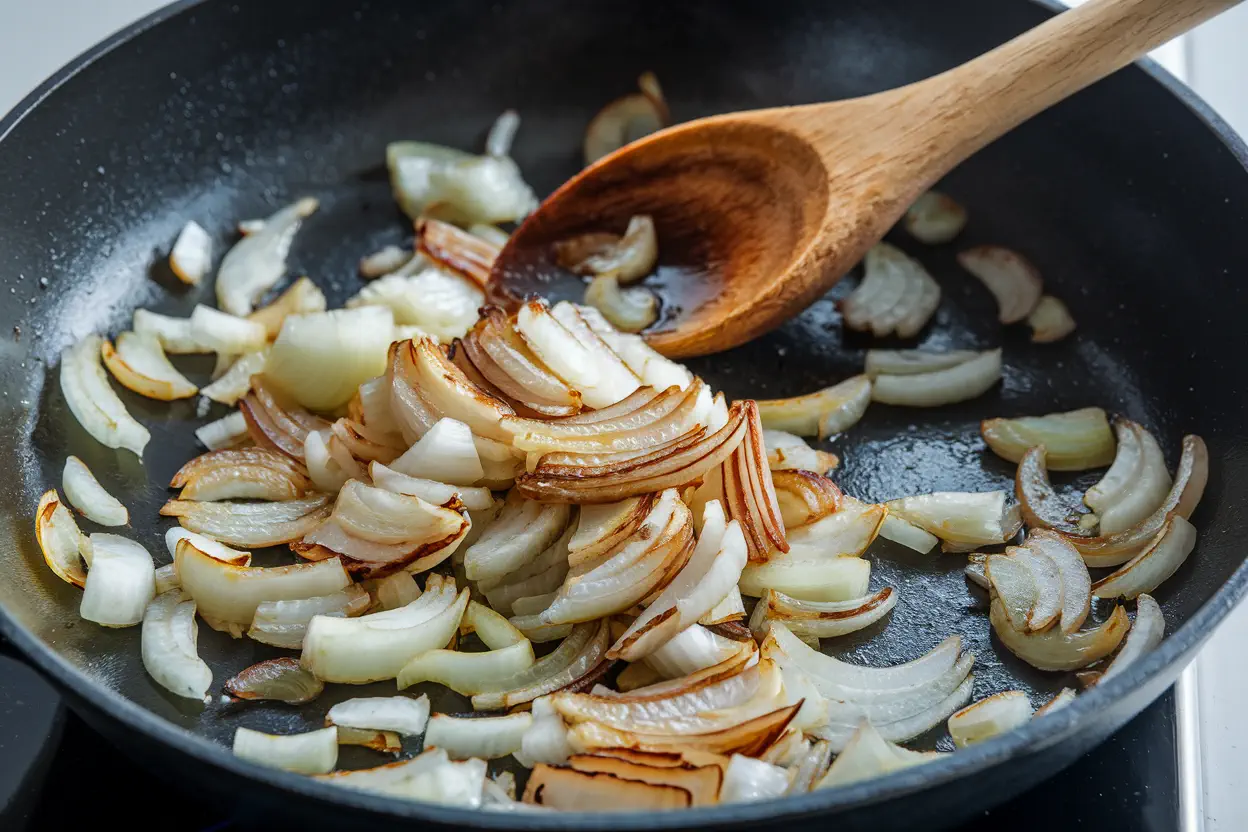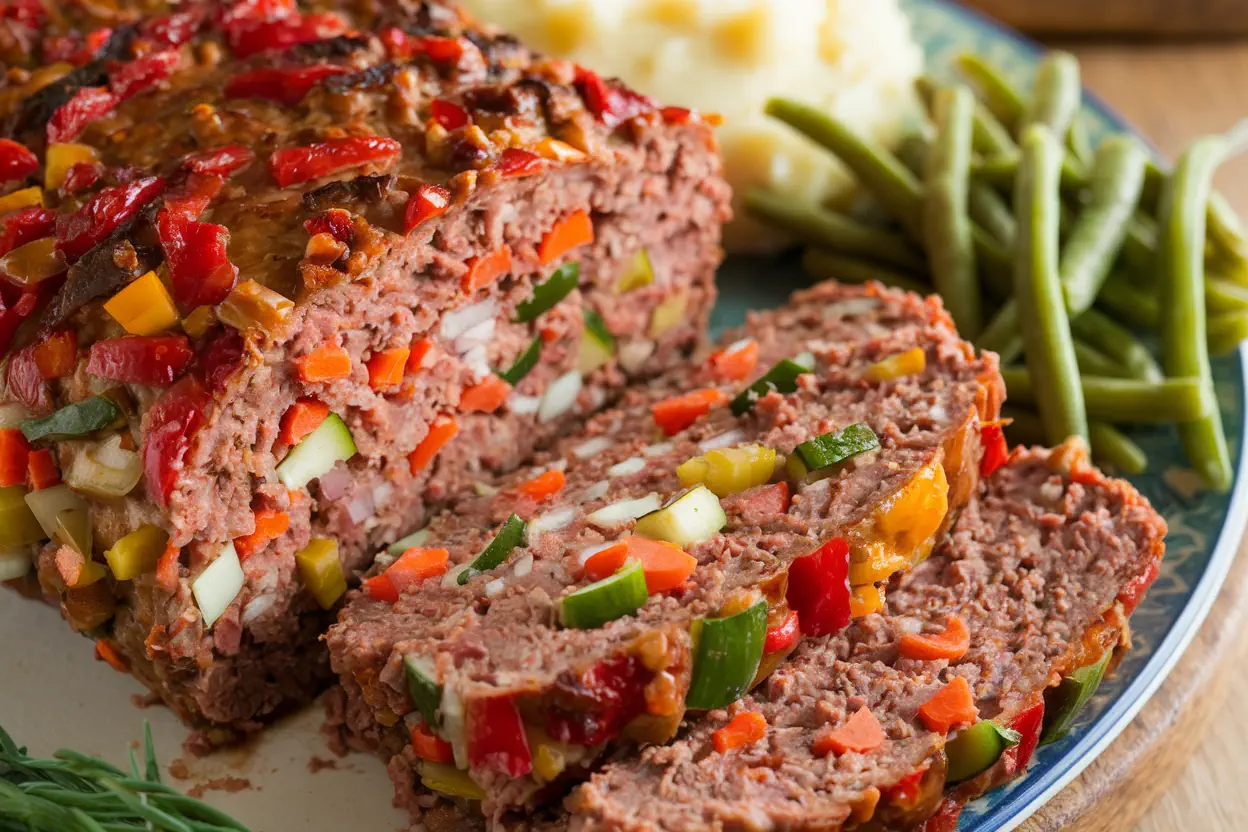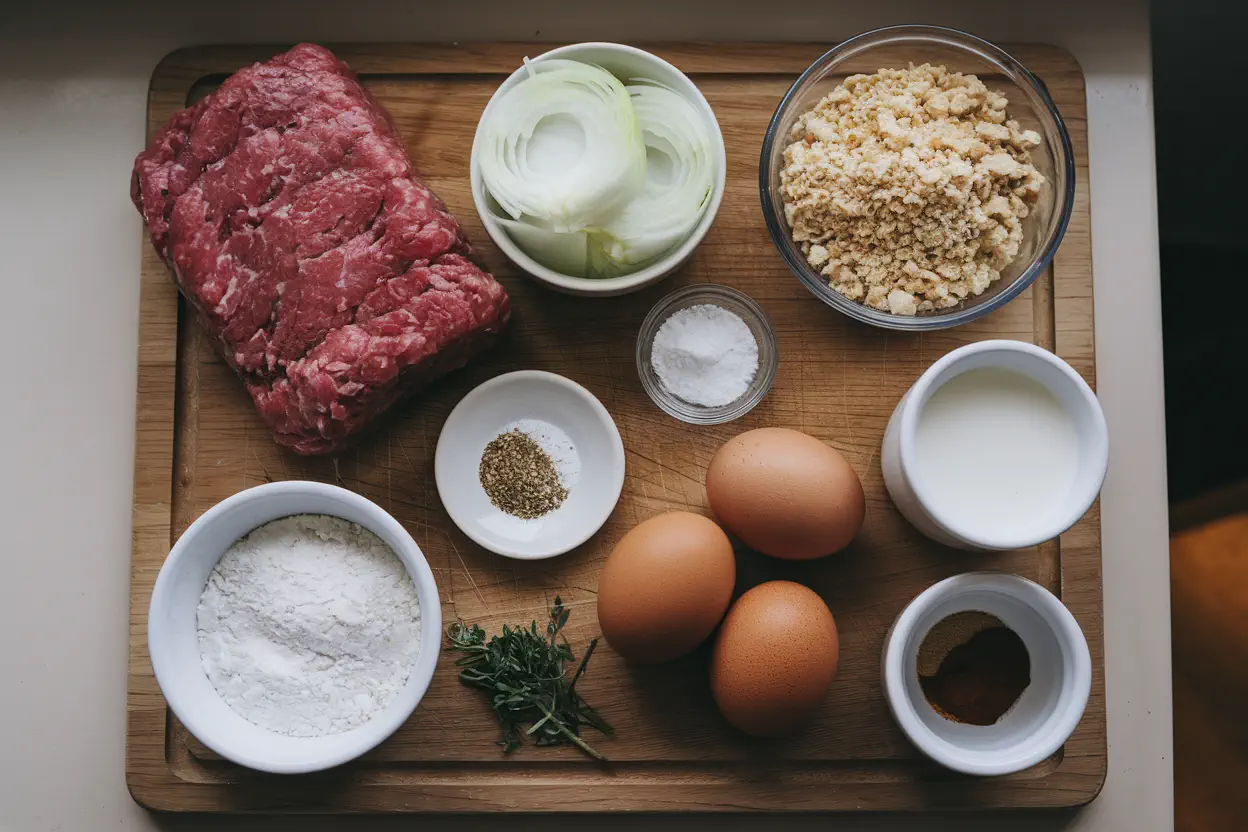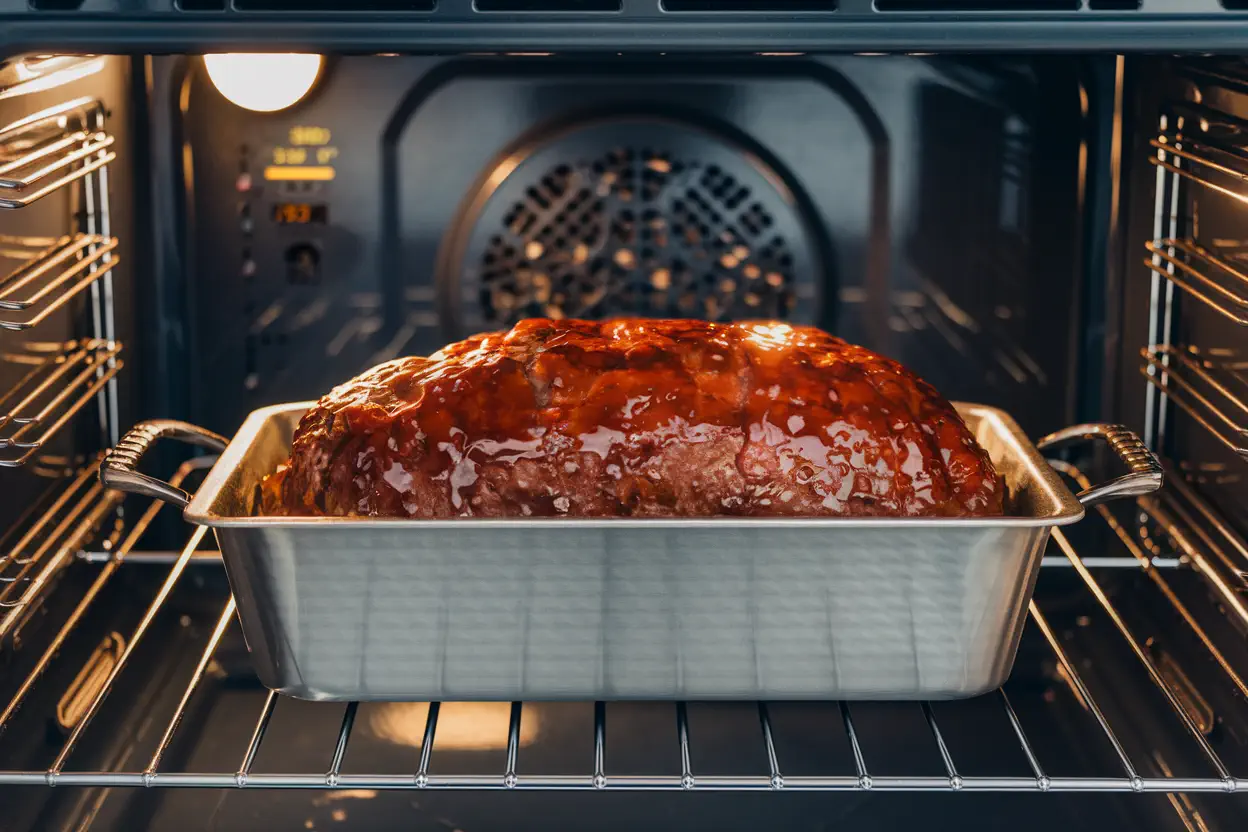Meatloaf is one of those comforting dishes, but many cooks ask, Should I cook my onions before putting in meatloaf? Yet, there’s a surprising debate surrounding one key ingredient: onions. Should you cook your onions before mixing them into your meatloaf, or is it fine to add them raw? This article dives into this juicy topic, exploring the pros and cons, preparation techniques, and expert tips to help you perfect your meatloaf recipe.
Table of Contents
The Importance of Onions in Meatloaf
What Role Do Onions Play in Meatloaf?
Onions aren’t just a simple addition to meatloaf—they’re a game-changer. These humble veggies bring natural sweetness, moisture, and depth of flavor to the dish. Their versatility allows them to blend seamlessly with other ingredients, ensuring each bite bursts with taste. Whether you’re working with yellow, sweet, or red onions, they contribute both texture and an aromatic foundation.
For those who love a meatloaf that’s packed with flavor, onions act as a supporting star. When properly integrated, they not only enhance the overall dish but also balance the richness of the meat.
Flavor and Texture: The Impact of Onions on the Final Dish
The way you prepare onions has a significant effect on your meatloaf. Raw onions can deliver a sharp, crunchy bite, which might not suit everyone’s palate. On the other hand, cooked onions melt into the meat mixture, lending a soft texture and more subdued, caramelized flavors.
Consider this: if you’re aiming for a smooth and evenly flavored meatloaf, cooking your onions beforehand might be the best choice. But, if you enjoy a more rustic texture with occasional bursts of oniony sharpness, raw onions could be your go-to. This decision hinges on personal preference and the type of meatloaf you want to serve.
Pros and Cons of Cooking Onions First

Benefits of Cooking Onions Before Adding to Meatloaf
Cooking onions before adding them to your meatloaf can transform the dish in subtle yet profound ways. First and foremost, sautéed onions have a sweeter and more mellow flavor, thanks to the caramelization process. This enhanced flavor profile creates a harmonious blend with the other ingredients in the meatloaf, elevating its overall taste.
Another major benefit is texture. Raw onions can stay firm even after baking, leading to unwelcome crunchy bits in the meatloaf. By cooking the onions, you soften their texture, ensuring they meld seamlessly with the meat. Additionally, pre-cooking eliminates the pungent sharpness of raw onions, making the dish more palatable for those sensitive to strong flavors.
Finally, cooking onions can release their natural sugars, adding moisture to the mixture. This is particularly helpful in avoiding a dry meatloaf—a common pitfall for many home cooks. If you’re striving for a moist, melt-in-your-mouth meatloaf, cooking your onions first could be the trick.
Drawbacks of Pre-Cooking Onions
Despite the benefits, there are a few downsides to cooking your onions beforehand. For one, it adds an extra step to the preparation process. If you’re short on time or aiming for a one-bowl recipe, this step can feel inconvenient.
Another concern is the risk of overcooking. Onions sautéed too long can become mushy, losing their distinct textureand flavor. Moreover, when added to the meatloaf mixture, overly cooked onions might break down further during baking, diminishing their impact.
Ultimately, whether to cook your onions comes down to personal preference and the type of meatloaf you’re making. In the next section, we’ll explore various methods for preparing onions to suit every style.
Methods for Preparing Onions for Meatloaf
Sautéing Onions: Step-by-Step Guide
Sautéing is the most common way to prepare onions for meatloaf. Here’s a quick guide:
- Heat a tablespoon of butter or oil in a skillet over medium heat.
- Add finely chopped onions and stir to coat them evenly.
- Cook for 5–7 minutes, stirring occasionally, until the onions turn translucent and slightly golden.
- Remove the skillet from the heat and allow the onions to cool before mixing them into your meatloaf.
This method ensures a balance between softness and sweetness, enhancing the overall dish.
Alternative Methods: Microwaving and Roasting
If you’re short on time, microwaving your onions can be a lifesaver. Simply place chopped onions in a microwave-safe bowl, cover it with a damp paper towel, and microwave on high for 2–3 minutes. This method softens the onions without adding extra fat.
For a bolder flavor, consider roasting your onions. Toss them with a bit of olive oil, spread them on a baking sheet, and roast at 400°F for about 15 minutes. Roasted onions add a smoky depth of flavor, perfect for gourmet-style meatloaf.
Raw Onions: When Skipping the Cook Works Best
In some cases, adding raw onions is a valid choice. If you finely grate the onions, they’ll integrate more evenly into the mixture, preventing large crunchy bits. This method works well for those who prefer a faster prep time or enjoy the sharp flavor of raw onions.
Looking for creative ways to enhance your meatloaf? Check out this recipe for secrets to a moist and flavorful meatloaf.
Expert Tips and Variations

Adding Peppers and Other Vegetables
Vegetables can elevate a meatloaf from good to unforgettable. Peppers, for example, are a popular addition alongside onions. When diced and sautéed, they lend a sweet and slightly tangy flavor that complements the meat. Carrots, celery, and zucchini are other great options. Grating these vegetables ensures they blend seamlessly into the meatloaf while adding moisture and nutrients.
For a unique twist, try adding mushrooms. Finely chopped and sautéed mushrooms can bring an umami boost, making your meatloaf taste more savory and rich. Regardless of the vegetables you choose, cooking them first ensures they’re tender and evenly integrated into the dish.
Using Different Types of Onions (Red, Yellow, Sweet)
Not all onions are created equal when it comes to meatloaf. Yellow onions are the go-to choice for their mild flavor that mellows when cooked. Sweet onions, like Vidalia, bring a natural sugariness that pairs beautifully with beef or pork. If you’re looking for a bolder taste, red onions are your best bet—just be sure to cook them first to tone down their sharpness.
Shallots are a fantastic alternative for a milder onion flavor, especially if you’re serving guests who prefer a more subtle taste. Don’t hesitate to experiment with combinations to find the perfect match for your recipe!
Flavor Enhancements: Spices and Herbs with Onions
Onions are a blank canvas for flavor. Mixing in spices like garlic powder, smoked paprika, or chili flakes can bring depth and excitement to your meatloaf. Fresh herbs such as parsley, thyme, and rosemary pair beautifully with onions, adding brightness and complexity to the dish.
For an extra kick, try sautéing onions with a splash of Worcestershire sauce or balsamic vinegar. These liquids caramelize with the onions, creating a rich, savory base for your meatloaf.
FAQs: Should I Cook My Onions Before Putting in Meatloaf? What Happens If I Don’t?
If you skip cooking the onions, you might end up with crunchy bits in your meatloaf. While some people enjoy the added texture, raw onions can overpower the flavor balance with their sharpness. Cooking them beforehand softens their bite and enhances the overall harmony of the dish.
Does the Cooking Method of Meatloaf Affect Onion Preparation?
Yes! If you’re slow-cooking or smoking your meatloaf, raw onions have more time to soften, making cooking them less necessary. However, for oven-baked meatloaf with a shorter cooking time, pre-cooking the onions ensures they don’t stay crunchy.
Can You Use Onion Alternatives Like Powder or Shallots?
Absolutely. If you’re short on time or prefer a smoother texture, onion powder or granulated onions can substitute fresh ones. Shallots, on the other hand, offer a milder, sweeter flavor that’s perfect for those who find regular onions too strong.
How to Fix Crunchy Onions in Meatloaf?
If your meatloaf is already in the oven and you’re worried about crunchy onions, don’t panic. Covering the meatloaf with foil during baking can create a steam effect, helping to soften the onions slightly. Next time, consider cooking the onions first or grating them for a finer texture.
For more detailed tips and tricks on making the ultimate meatloaf, check out this recipe.
Step-by-Step Recipe with Variations

Basic Meatloaf Recipe with Cooked Onions
Here’s a classic meatloaf recipe that answers the question Should I cook my onions before putting in meatloaf? with a resounding yes!
Ingredients:
- 1 lb ground beef (or a mix of beef and pork)
- 1 cup breadcrumbs
- 1 egg
- 1 medium yellow onion, finely chopped and sautéed
- 1/2 cup milk
- 2 tbsp ketchup
- 1 tsp Worcestershire sauce
- 1 tsp garlic powder
- Salt and pepper to taste
Instructions:
- Preheat your oven to 350°F (175°C) and grease a loaf pan.
- Heat a skillet over medium heat. Add a small amount of oil and sauté the chopped onions until they’re translucent and golden. Let them cool.
- In a large bowl, mix the ground meat, breadcrumbs, egg, milk, ketchup, Worcestershire sauce, garlic powder, and the cooled onions. Season with salt and pepper.
- Transfer the mixture to the prepared loaf pan, shaping it into a loaf.
- Bake for 50–60 minutes, or until the internal temperature reaches 160°F (70°C).
- Let the meatloaf rest for 5 minutes before slicing and serving.
Adjusting for Dietary Preferences and Allergies
For a gluten-free version, swap the breadcrumbs for crushed gluten-free crackers or almond flour. If you’re lactose intolerant, replace the milk with unsweetened almond or oat milk.
Creative Additions for Unique Flavors
To give your meatloaf a Mediterranean twist, add crumbled feta cheese and chopped sundried tomatoes. For a smoky barbecue flavor, mix in a tablespoon of barbecue sauce and some smoked paprika. These variations allow you to personalize your meatloaf while maintaining its classic appeal.
FAQs and Final Thoughts
FAQs About Cooking Onions for Meatloaf
Should I cook my onions before putting in meatloaf?
If you’re wondering, Should I cook my onions before putting in meatloaf? the answer lies in how cooking softens their flavor, ensuring they harmonize with the meat mixture, and eliminates the risk of raw, crunchy bits in your meatloaf. However, if you’re short on time, finely grating raw onions can also work.
What’s the best way to incorporate onions into meatloaf?
Sautéed onions offer a sweet, caramelized flavor that blends perfectly with the meat mixture. If using raw onions, grate them finely to ensure even distribution and faster cooking.
Can I skip onions in meatloaf altogether?
While onions are a key ingredient for flavor, you can skip them if necessary. Consider using onion powder or other vegetables, like grated zucchini or carrots, to maintain the moisture and taste.
What’s the secret to moist meatloaf?
In addition to cooking your onions, using a combination of breadcrumbs and milk, adding an egg, and not overmixing the meat are all crucial steps for a juicy meatloaf.
Final Thoughts
Whether you choose to cook your onions or use them raw, the decision ultimately depends on your taste and time constraints. For most, sautéed onions provide the ideal mix of flavor and texture, ensuring a meatloaf that’s anything but ordinary. Give this method a try, and you may never go back to raw onions again!
Want more tips on meatloaf-making? Check out this article for expert advice.
Common Mistakes When Preparing Onions for Meatloaf
Overlooking the Cooking Step
One of the most common mistakes is skipping the cooking step entirely. Many wonder, Should I cook my onions before putting in meatloaf? The answer largely depends on personal preference, but raw onions can retain a sharp taste and firm texture that may not blend well with the other ingredients. Cooking onions softens their flavor, ensuring they harmonize with the meat mixture.
Failing to cook the onions also risks uneven distribution of flavor throughout the meatloaf. Even if you’re in a rush, sautéing them for just a few minutes can make a noticeable difference.
Using Large Onion Chunks
Another frequent misstep is chopping the onions too coarsely. Large pieces take longer to cook and may stay crunchy even after the meatloaf is fully baked. This can be unpleasant for those who prefer a smooth, cohesive texture.
For the best results, finely dice or grate your onions. This ensures even cooking and eliminates the possibility of encountering overly large, raw bits in the finished dish.
Forgetting to Let Cooked Onions Cool
If you cook your onions before adding them to the meatloaf, it’s crucial to let them cool first. Adding hot onions directly to raw meat can partially cook the mixture prematurely, affecting its texture. Always allow the onions to reach room temperature before mixing.
Tools and Tricks for Perfect Onion Preparation
Must-Have Kitchen Tools
To prepare onions for meatloaf efficiently, having the right tools can save you time and effort. A sharp chef’s knife is essential for dicing onions finely. Alternatively, a food processor can help you achieve a uniform texture quickly, especially if you’re making a large batch.
A non-stick skillet is ideal for sautéing, as it prevents sticking and ensures even cooking. If you’re roasting your onions, use a lined baking sheet to avoid a sticky mess.
Time-Saving Tricks
If you’re short on time but still want cooked onions in your meatloaf, consider microwaving them. Place finely chopped onions in a microwave-safe bowl, cover them with a damp paper towel, and heat for 2–3 minutes. This method softens the onions without adding oil or requiring stovetop attention.
Grating onions is another quick fix. Grated onions blend effortlessly into the meat mixture, eliminating the need for cooking altogether. However, this method works best for recipes where raw onions are acceptable.
Pro Tip: Freeze Pre-Cooked Onions
If you frequently cook meatloaf or similar dishes, preparing a batch of sautéed onions in advance can be a game-changer. Once cooled, divide the cooked onions into portions and freeze them in airtight bags. When you’re ready to make meatloaf, simply thaw and mix them in for an effortless preparation process.

